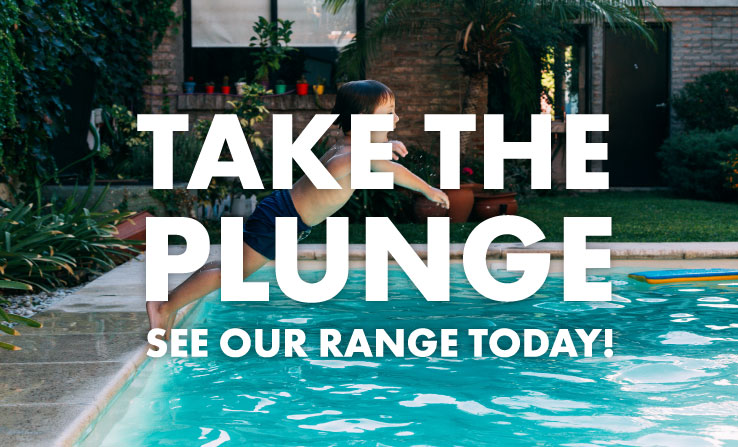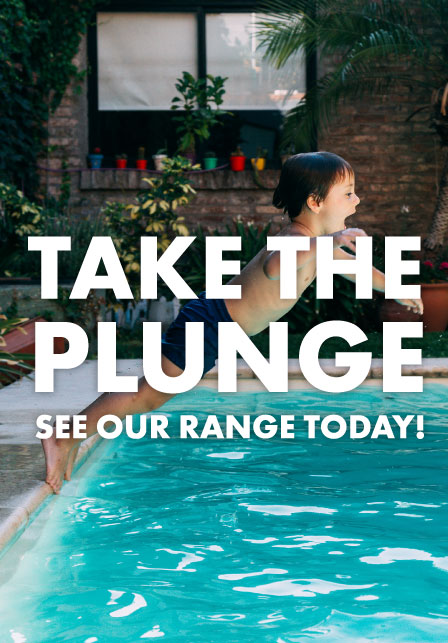Pets and Pools: Safety Considerations
Owning both a pool and a pet can bring immense joy and relaxation to your home. However, as these two worlds converge, it's essential to strike a balance between enjoyment and safety. In recent years, there has been a growing trend of pet-friendly pool features in homes, reflecting the increasing importance of pet safety in outdoor spaces. This blog post will delve into the various safety considerations every pet and pool owner should be aware of to ensure both a fun and safe environment for everyone.
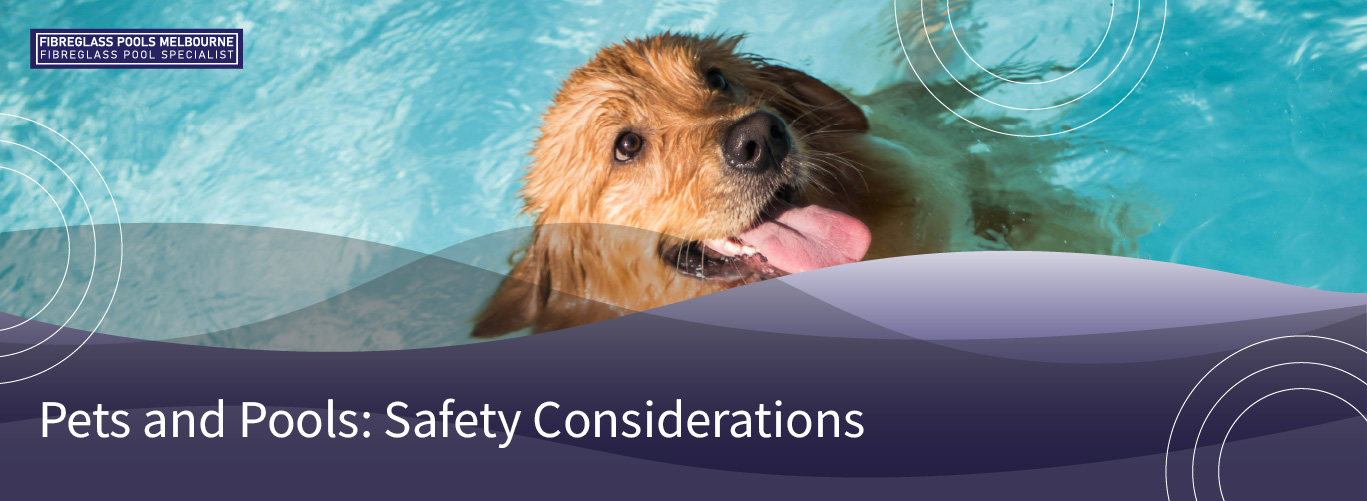
Pool Safety Measures for Pets
Fencing and Enclosures
Securing the pool area is the first step in ensuring pet safety. A well-constructed fence or enclosure can prevent pets from accessing the pool area unsupervised. Here are some tips:
- Height and Design: Ensure the fence is tall enough (ideally at least 4 feet) to prevent pets from jumping over, and consider designs that don’t provide footholds for climbing.
- Self-Closing Gates: Install self-closing and self-latching gates to ensure the pool area remains secure even if you forget to close it manually.
- Mesh Barriers: These are effective for keeping smaller pets out of the pool area while still providing visibility.
Pet Safety Alarms
Technology can play a significant role in enhancing pet safety around pools. Pet safety alarms are designed to alert you when your pet enters the water.
- Wearable Alarms: Devices that attach to your pet’s collar and send alerts to a base station when they get wet.
- Surface Alarms: These are installed on the pool surface and detect disturbances in the water, alerting you if a pet falls in.
Pool Covers
Investing in a quality pool cover can prevent accidents and keep your pool clean.
- Solid Covers: These are the safest, as they can support weight and prevent accidental falls.
- Mesh Covers: While not as strong as solid covers, they can still provide a barrier to keep pets out of the water.
- Solar Covers: Be cautious with these as they can trap pets underneath, making them less ideal for pet safety.
Pet Water Safety Training
Training your pets to navigate the pool area safely can be a lifesaver.
- Teach Exit Strategies: Train your pets on how to find and use the pool steps or a ramp to exit the pool.
- Supervised Swim Sessions: Familiarise your pets with the pool under supervision to boost their confidence and swimming skills.
- Floatation Devices: Consider using pet floatation devices to provide extra security during swim sessions.
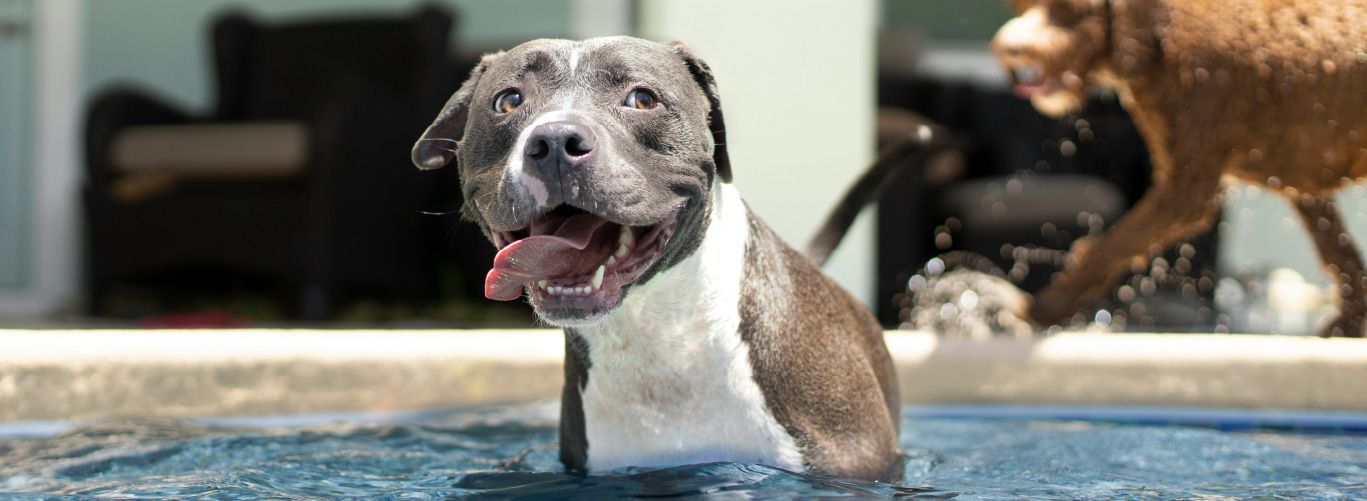
Pet Pool Health and Hygiene
Impact of Pets on Pool Water Quality
Pets can introduce contaminants like fur, dirt, and pet dander into the pool, affecting water quality.
- Regular Skimming: Use a skimmer to remove debris and fur from the pool surface regularly. This prevents clogging and keeps the water clean for both humans and pets. Aim to skim the pool at least once a day, especially if your pet swims frequently.
- Filtration System: Ensure your pool’s filtration system is efficient and well-maintained to handle the extra load from pet use. Check and clean the filters more often than usual, perhaps every couple of days, to ensure they are not overwhelmed by pet hair and other debris.
Maintenance Practices
A clean pool is a safe pool, both for humans and pets.
- Regular Testing: Test the pool water regularly for pH, chlorine levels, and other chemicals to maintain a balanced environment. Use a reliable test kit to ensure accurate readings and make necessary adjustments for optimal water quality.
- Shock Treatment: Periodically shock the pool to eliminate bacteria and contaminants. This involves adding a high dose of chlorine or other chemical sanitizer to the water to kill off any unwanted organisms and maintain a safe swimming environment.
- Consistent Cleaning: Vacuum the pool floor and walls to remove accumulated dirt and pet-related debris. Additionally, use a skimmer to clear the water surface of leaves and other floating debris, and clean the pool filter regularly to ensure efficient filtration.
Protecting Pets from Harmful Pool Chemicals
Pool chemicals, if not managed properly, can be harmful to pets.
- Rinse Pets After Swimming: Always rinse your pets with fresh water after swimming to remove chlorine, salt, and other chemicals from their fur, which can cause irritation and dryness. This simple step can help keep their skin and coat healthy.
- Chemical Storage: Store pool chemicals securely out of pets’ reach in a locked cabinet or a high shelf. Proper storage prevents accidental ingestion or contact, which can be harmful or even fatal to pets.
- Natural Alternatives: Consider using pet-friendly pool treatments such as mineral sanitizers or saltwater systems. These alternatives are gentler on your pets’ skin and coat while still maintaining clean and safe pool water. Exploring these options can make a big difference for your furry friends.
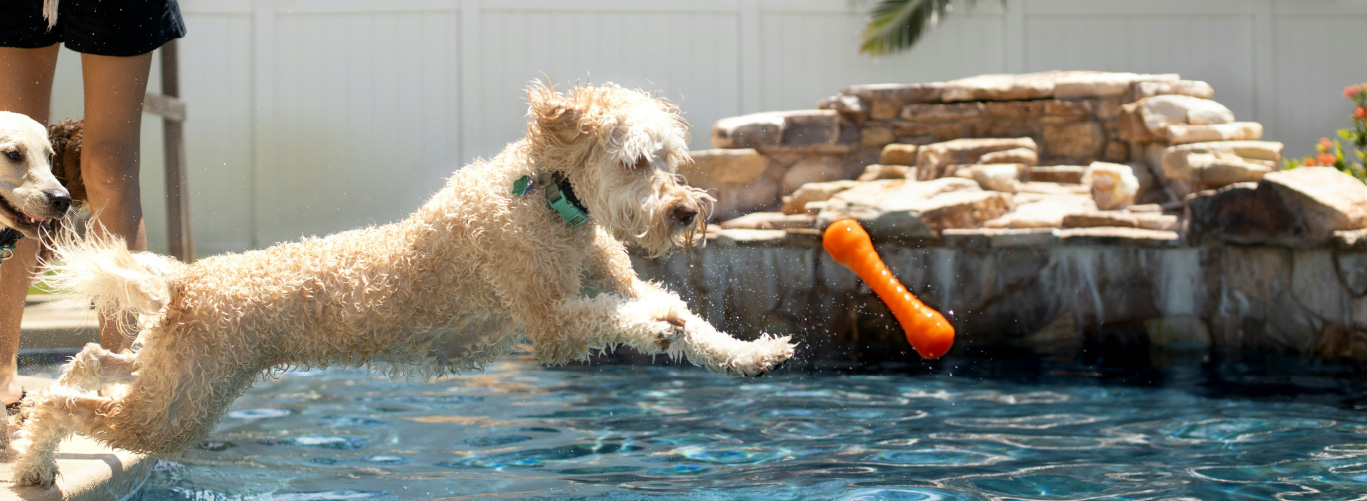
Pet-Safe Pool Landscaping
Pet-Friendly Plants and Landscaping
Certain plants and landscaping choices can enhance pool safety and enjoyment for pets.
- Non-Toxic Plants: Stick to non-toxic plants such as sunflowers, marigolds, and snapdragons to avoid potential poisoning. These plants not only add vibrant colours to your garden but also ensure the safety of your pets and small children who might come into contact with them.
- Soft Ground Coverings: Use pet-safe ground coverings like Bermuda grass or clover for a soft landing around the pool. These coverings provide a comfortable surface for running and playing, reducing the risk of injuries while also creating a lush, green environment.
Providing Shaded Areas
Pets need a place to cool down and rest after frolicking in the water.
- Umbrellas and Awnings: Install umbrellas or awnings around the pool area to provide shaded spots.
- Trees and Bushes: Plant trees or bushes strategically to create natural shade without dropping leaves into the pool.
Conclusion
Creating a safe and enjoyable pool environment for your pets requires a combination of preventive measures, training, and regular maintenance. By fencing your pool, employing safety alarms, using reliable pool covers, and maintaining high hygiene standards, you can significantly reduce the risk of accidents. Additionally, thoughtful landscaping and providing shaded areas further enhance the pool experience for your furry friends.
Remember, the safety and well-being of your pets around the pool are paramount. By implementing the tips and strategies discussed in this post, you can ensure that your pool remains a delightful and safe haven for both you and your pets.
Pets and Pools: Safety Considerations
Owning both a pool and a pet can bring immense joy and relaxation to your home. However, as these two worlds converge, it's essential to strike a balance between enjoyment and safety. In recent years, there has been a growing trend of pet-friendly pool features in homes, reflecting the increasing importance of pet safety in outdoor spaces. This blog post will delve into the various safety considerations every pet and pool owner should be aware of to ensure both a fun and safe environment for everyone.
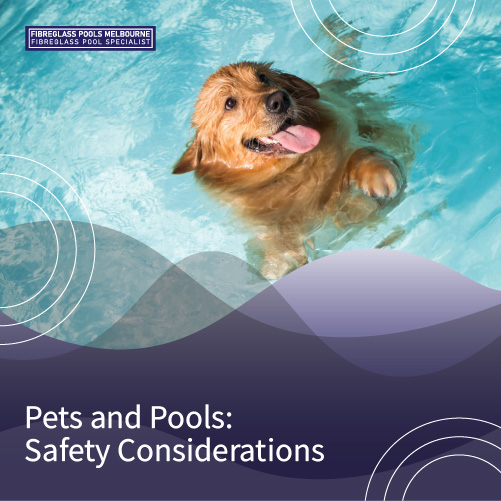
Pool Safety Measures for Pets
Fencing and Enclosures
Securing the pool area is the first step in ensuring pet safety. A well-constructed fence or enclosure can prevent pets from accessing the pool area unsupervised. Here are some tips:
- Height and Design: Ensure the fence is tall enough (ideally at least 4 feet) to prevent pets from jumping over, and consider designs that don’t provide footholds for climbing.
- Self-Closing Gates: Install self-closing and self-latching gates to ensure the pool area remains secure even if you forget to close it manually.
- Mesh Barriers: These are effective for keeping smaller pets out of the pool area while still providing visibility.
Pet Safety Alarms
Technology can play a significant role in enhancing pet safety around pools. Pet safety alarms are designed to alert you when your pet enters the water.
- Wearable Alarms: Devices that attach to your pet’s collar and send alerts to a base station when they get wet.
- Surface Alarms: These are installed on the pool surface and detect disturbances in the water, alerting you if a pet falls in.
Pool Covers
Investing in a quality pool cover can prevent accidents and keep your pool clean.
- Solid Covers: These are the safest, as they can support weight and prevent accidental falls.
- Mesh Covers: While not as strong as solid covers, they can still provide a barrier to keep pets out of the water.
- Solar Covers: Be cautious with these as they can trap pets underneath, making them less ideal for pet safety.
Pet Water Safety Training
Training your pets to navigate the pool area safely can be a lifesaver.
- Teach Exit Strategies: Train your pets on how to find and use the pool steps or a ramp to exit the pool.
- Supervised Swim Sessions: Familiarise your pets with the pool under supervision to boost their confidence and swimming skills.
- Floatation Devices: Consider using pet floatation devices to provide extra security during swim sessions.

Pet Pool Health and Hygiene
Impact of Pets on Pool Water Quality
Pets can introduce contaminants like fur, dirt, and pet dander into the pool, affecting water quality.
- Regular Skimming: Use a skimmer to remove debris and fur from the pool surface regularly. This prevents clogging and keeps the water clean for both humans and pets. Aim to skim the pool at least once a day, especially if your pet swims frequently.
- Filtration System: Ensure your pool’s filtration system is efficient and well-maintained to handle the extra load from pet use. Check and clean the filters more often than usual, perhaps every couple of days, to ensure they are not overwhelmed by pet hair and other debris.
Maintenance Practices
A clean pool is a safe pool, both for humans and pets.
- Regular Testing: Test the pool water regularly for pH, chlorine levels, and other chemicals to maintain a balanced environment. Use a reliable test kit to ensure accurate readings and make necessary adjustments for optimal water quality.
- Shock Treatment: Periodically shock the pool to eliminate bacteria and contaminants. This involves adding a high dose of chlorine or other chemical sanitizer to the water to kill off any unwanted organisms and maintain a safe swimming environment.
- Consistent Cleaning: Vacuum the pool floor and walls to remove accumulated dirt and pet-related debris. Additionally, use a skimmer to clear the water surface of leaves and other floating debris, and clean the pool filter regularly to ensure efficient filtration.
Protecting Pets from Harmful Pool Chemicals
Pool chemicals, if not managed properly, can be harmful to pets.
- Rinse Pets After Swimming: Always rinse your pets with fresh water after swimming to remove chlorine, salt, and other chemicals from their fur, which can cause irritation and dryness. This simple step can help keep their skin and coat healthy.
- Chemical Storage: Store pool chemicals securely out of pets’ reach in a locked cabinet or a high shelf. Proper storage prevents accidental ingestion or contact, which can be harmful or even fatal to pets.
- Natural Alternatives: Consider using pet-friendly pool treatments such as mineral sanitizers or saltwater systems. These alternatives are gentler on your pets’ skin and coat while still maintaining clean and safe pool water. Exploring these options can make a big difference for your furry friends.
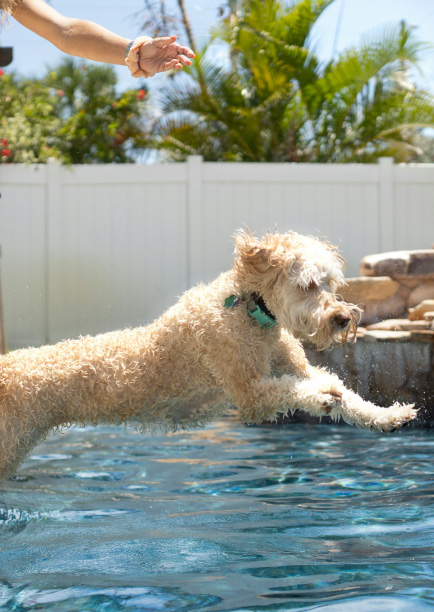
Pet-Safe Pool Landscaping
Pet-Friendly Plants and Landscaping
Certain plants and landscaping choices can enhance pool safety and enjoyment for pets.
- Non-Toxic Plants: Stick to non-toxic plants such as sunflowers, marigolds, and snapdragons to avoid potential poisoning. These plants not only add vibrant colours to your garden but also ensure the safety of your pets and small children who might come into contact with them.
- Soft Ground Coverings: Use pet-safe ground coverings like Bermuda grass or clover for a soft landing around the pool. These coverings provide a comfortable surface for running and playing, reducing the risk of injuries while also creating a lush, green environment.
Providing Shaded Areas
Pets need a place to cool down and rest after frolicking in the water.
- Umbrellas and Awnings: Install umbrellas or awnings around the pool area to provide shaded spots.
- Trees and Bushes: Plant trees or bushes strategically to create natural shade without dropping leaves into the pool.
Conclusion
Creating a safe and enjoyable pool environment for your pets requires a combination of preventive measures, training, and regular maintenance. By fencing your pool, employing safety alarms, using reliable pool covers, and maintaining high hygiene standards, you can significantly reduce the risk of accidents. Additionally, thoughtful landscaping and providing shaded areas further enhance the pool experience for your furry friends.
Remember, the safety and well-being of your pets around the pool are paramount. By implementing the tips and strategies discussed in this post, you can ensure that your pool remains a delightful and safe haven for both you and your pets.

